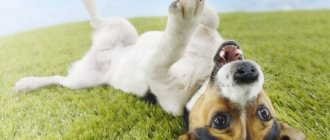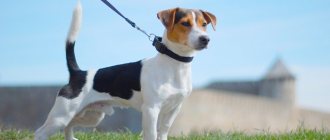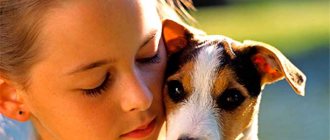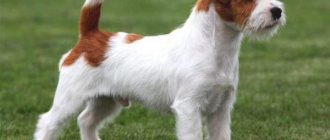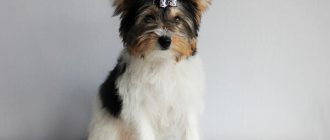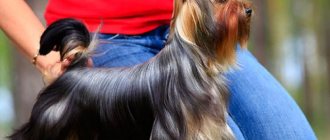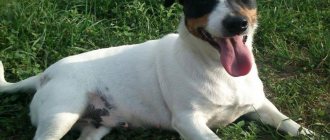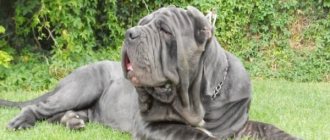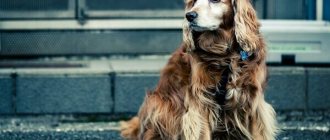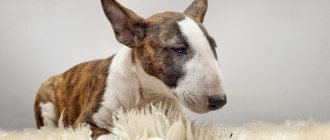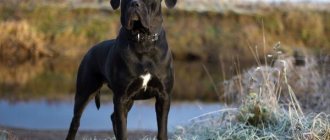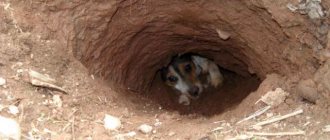Jack Russell Terriers are one of the most popular breeds in the world. This was largely due to the cult film “The Mask” and Jim Carrey’s pet Milo. A hunting dog in the past, today the compact Jack Russell is a sweet family member. But be aware: this little dog has a truly frantic temperament and irrepressible activity - he can’t sit still.
Restless and cheerful, the Jack Russell will become a friend and playmate for little children. A dog can easily be trained to fetch a ball and carry out more complex commands. This little guy is a fearless defender who is not afraid to attack a large dog.
Another plus of the breed is that Jack Russells are long-lived in the dog world. They delight owners for 14-16 years. Such an energetic hunting dog is not prone to gaining excess weight, is naturally in good health, and does not suffer from hereditary pathologies. However, owners must provide the kitten with proper care, diet, and monitor its weight gain.
Jack Russell Terrier puppies - photos and weight by month
Jack Russell Terriers are one of the most popular breeds in the world.
This was largely due to the cult film “The Mask” and Jim Carrey’s pet Milo. A hunting dog in the past, today the compact Jack Russell is a sweet family member. But be aware: this little dog has a truly frantic temperament and irrepressible activity - he can’t sit still. Restless and cheerful, the Jack Russell will become a friend and playmate for little children. A dog can easily be trained to fetch a ball and carry out more complex commands. This little guy is a fearless defender who is not afraid to attack a large dog.
Another plus of the breed is that Jack Russells are long-lived in the dog world. They delight owners for 14-16 years. Such an energetic hunting dog is not prone to gaining excess weight, is naturally in good health, and does not suffer from hereditary pathologies. However, owners must provide the kitten with proper care, diet, and monitor its weight gain.
Character and behavior
Jack Russells were originally bred as burrowing terriers for hunting foxes and even rats. For a long time, professional breeders fought for the purity and quality of hunting qualities. And they were categorically against breeding exhibition specimens. But with the decline in the popularity of hunting, this breed was increasingly kept at home due to its cheerful and playful disposition.
The breed appeared in Russia only in the late nineties. Only in 2003, the National Club (Russell Terrier breeds) was organized, and therefore puppies are still quite expensive. Because of this, their popularity is not so high. But many people want to have a dog from the movie “The Mask” at home.
The Jack Russell Terrier is small in stature (up to 30 cm at the withers), so it can be kept freely even in the smallest apartment . As a rule, the pet's toys take up more space, not the pet itself. They are very jumpy and are happy to wake up their owner in the morning. They do not require the selection of an alpha individual in the family. They communicate easily and on the same level with all family members, but they can choose a favorite for themselves.
Long-haired with a beard
The character of such dogs is quite restless . Phlegmatic people are better off not getting a Jack Russell, but take, for example, an eternally sleeping pug, because Jack constantly needs active games and communication. This terrier will happily go for a run with its owner, making it even more fun.
Jack Russell Terriers are very good with children . They will entertain not only their own people, but even strangers. But, if you get such a dog for a child under 3 years old, then you need to pay a lot of attention to training. So that the pet does not snap when during play it may be pulled by the tail or squeezed too tightly in a hug. It is very important to explain to the dog that the child has a routine. Otherwise, the terrier will entertain his little charge to the point of complete exhaustion and wake him up at inopportune times.
Photo while jogging
Dogs of this breed have a high level of intelligence , so they are easy to teach commands even without a trainer. Jacks enjoy training and participating in agility competitions (or, more simply, completing an obstacle course for small breeds).
How long do these dogs live? For a long time, because when breeding the breed, interference with healthy physiology was not allowed. But with poor nutrition, there may not be enough energy for the heart, so the condition of cardiovascular system must be closely monitored.
From lack of attention, these terriers can develop neuroses. Then their condition can be compared with the behavior of a hyperactive child. The dog can play at night, drag away various objects and tear them to shreds. Even such a small pet, with attention deficit, can independently destroy a soft bedroom set or deprive the owner of several pairs of shoes.
Active and cheerful
Weight table by month
This chart of average puppy weights and heights will help you keep track of the development of your little Jack Russell Terrier.
| Age (months): | Weight (kg): | Height at withers (cm): |
| 1 | 0,7-1 | 8-9 |
| 2 | 2,5-3 | 10 |
| 3 | 4 | 11 |
| 4 | 4,1 | 12 |
| 5 | 4,3 | 13 |
| 6 | 4,5 | 15 |
| 7 | 4,6 | 17 |
| 8 | 4,7 | 19 |
| 9 | 4,8 | 20 |
| 10 | 4,9 | 22 |
| 11-12 | 5-6 | 25-30 |
Small deviations from the given values (within 100 g, 1-2 cm) are not dangerous, either more or less - this is the individualized development of the dog. The owner should be concerned about a significant difference: too rapid growth, developmental delay, deficiency or excess weight of the animal.
Breeders and professional owners also use a simple formula for calculating the ideal weight for their pets: per 5 cm of height (meaning height at the withers) - 1 kg of weight. Thus, a three-kilogram dog should not be lower than 15 cm. And for a 30-centimeter dog, the suitable weight is within 6 kg.
Breed characteristics
| Short description | |
| Origin: | Great Britain |
| Conditions of detention: | In an apartment/in a house |
| Purpose: | Mainly a working hunting dog, with proper training can be successfully used as a companion dog |
| Color: | White, red, yellow or black spots allowed, mainly on the head or tail |
| Wool length: | Short, less than 5 cm, bristly, with undercoat |
| Adult dog size: | Weight: 6-8 kg Height: 33-36 cm |
| Average life expectancy: | 13-15 years old |
| Walk: | Long walks required, 2-3 times a day |
| Physical activity needs: | High, requires daily, active games lasting at least 1 hour with high intensity |
| Fédération Cynologique Internationale (FIC) classification: | Recognized by the FCI in 2001 Group 3. Terriers/Section 1. Large and medium terriers |
| Puppy price: | Without breeding rights - 15-25 thousand rubles For exhibitions and mating - 35-45 thousand rubles |
Puppy development and growth
Jack Russells are a breed of small dogs, which is why males and females practically do not differ in size and character. Dog handlers testify that the optimal weight for adult representatives of the breed is within 5-6 kg. With such a mass, the Jack Russell feels great, proportionate and harmoniously built. Both underweight and excess body weight can predictably lead to health problems.
Adult Jack Russells cannot be called oversized - their sternum volume fits into 40-45 cm. In terms of its physique, it is an ideally proportional dog: 50% - body, 50% - limbs. The Jack Russell can be mentally fit into a regular rectangle, but not into a square. These are not dense animals like bull terriers, and not short-legged animals like dachshunds.
Don’t forget that not all dogs are genetically “programmed” to conform to the norm. There will be both smaller and larger puppies in the litter. It’s not a fact that a plump kitten will grow into the biggest dog among his brothers and sisters. Along with this, a small and slender last-born adult will most likely be as active and healthy as its larger counterparts.
On average, Jack Russells stop growing and physically developing by the 11-12th month of life. If this happened much earlier, there is a reason to visit the veterinarian. Perhaps the lack of certain beneficial elements, pathologies hidden from the layman, affect the release of growth hormone.
Teaching first commands
After the puppy has acquired the basic skills, it’s time to learn the simplest commands. The Jack Russell baby is ready to train at the age of 6 weeks. The commands you should start training with are presented in the table below along with the age at which they are easiest to learn.
Table 2. Study of commands from 6 weeks to 6 months of age
| Puppy age | Team | How to train |
| 6 weeks – 2 months | Puppy's name | The nickname should be called every time you contact your pet and rewarded if he responds to his name |
| 2-3 months | "To me!" | The owner shows the dog a treat held in his palm and calls him to him with a gesture |
| 3-3.5 months | "Lie!" | The treat is placed in front of the dog. If she does not lie down, gently help her by pressing on the croup. |
| 3.5-4 months | "Ugh!" | The owner says “Ugh!” when the puppy grabs garbage from the ground while walking. In case of disobedience, the command is repeated more strictly. If during a walk your pet wanders off to the side, you need to say “Ugh!” and pull the leash towards you |
| "Sit!" | The trainer holds a piece of treat above the puppy's head so that he can notice it only after he sits down. | |
| 4-6 months | "Near!" | During walks, the puppy is kept on a leash near the owner's left leg. At first they teach to sit and stand next to the owner, and then |
It is recommended to learn no more than two commands in one lesson. Each order must be repeated constantly so that the puppy does not forget the commands. This course is designed so that the child gets used to training gradually - from simple commands to complex ones. A new command should be given to the pet to study after the previous one has been reinforced.
Important! After the owner has shown the pet the action for the command and announced its name, nothing can be changed. Otherwise, the puppy will get confused and will not follow orders.
Factors influencing growth
It is much easier to ensure the harmonious development of your Jack Russell Terrier if you know the main factors affecting the pet’s height and weight. Their most serious influence is in the period from birth to 1 year of life.
Thus, developmental delay is most often caused by the following:
- Congenital, hereditary diseases.
- Poor quality, insufficient, low-calorie nutrition.
- Poor living conditions - cold, damp, drafts, constant noise, systemic stress.
- Worm infestation.
- Poor living conditions for the mother dog during pregnancy and lactation.
- Untimely, incorrect introduction of complementary foods, too early weaning from mother's milk.
- Insufficient level of lactation in the mother dog during the suckling stage of the puppies' life.
- Lack of supplements of vitamins and microelements necessary for cuties.
- Insufficient or, on the contrary, excessive, debilitating physical activity.
To restore the harmonious development of the puppy, it is better not to let the problem take its course, and not to try to fix it yourself without the necessary education and experience. The best option is to seek help from a veterinarian. Depending on the source of the problem, the solution is found:
- Deviation from the norm during the suckling period. The kitten is placed on the dog's rear nipples, where more milk collects. This situation is typical for multiple litters: stronger puppies push the weaker ones away from the nipples. If there is not enough milk for everyone, then artificial nutrition is introduced and a nurse dog is found. When the puppies are already grown up, with the approval of a specialist, they are introduced to complementary foods ahead of schedule.
- Underweight after purchasing a puppy. Perhaps this is how stress affects the baby - a new home, separation from his mother and siblings. The new owner must surround the baby with attention and care, adjust his diet: add calcined cottage cheese with one yolk, a couple of spoons of whey and 2 drops of a multivitamin.
- Developmental delay is a consequence of helminthic infestation. If the conditions for keeping the animal are ideal, the diet is correct, the reason for the low weight may be helminths. The necessary tests are carried out, the puppies are prescribed Dirofen, Prazitel, Helmintal, etc.
Training
Russells are trained depending on the purpose for which they purchased the dog. A hunting dog is raised by one set of rules, a companion by another. Hunting skills are best developed by specialists in canine organizations. This is a rather difficult process that develops in the dog courage, perseverance, and the ability to make decisions. A domestic Russell is a completely different matter. They are quite obedient, but it is forbidden to tease the dog, and you cannot use methods such as beating and screaming in training. It is best to use the incentive method.
For more information about the characteristics of this breed, see the following video.
Brief information about the breed
Dogs of this breed were bred in Great Britain for burrowing . The breed combines small size, strength, courage and powerful jaws. All this was needed to penetrate the hole and grab prey.
Nowadays, the Jack Russell Terrier has an average weight of 5-7 kg, and a height at the withers of 25-31 cm. The skull is slightly narrowed towards the eyes. The eyes themselves are shaped like almonds, dark and deep-set. The chest has a girth of 40-43 cm, the tail is docked. The life expectancy of dogs of this breed with proper care is on average up to 14-15 years.
From the first days, Jack Russell Terrier puppies are characterized by excessive activity and a desire to dominate their owner, therefore, in order to turn a Russell into a well-mannered dog, you will have to make a lot of effort. Raising a Jack Russell should take place without shouting and beating, but at the same time without indulging in all the dog’s pranks, which will turn the puppy into a real little devil in the future.
To prevent bad behavior, you need to stop any antics of your pet, not be touched by his pranks, and not allow the dog to become the main one in the house and manipulate you.
Breed characteristics, behavioral characteristics
This breed is characterized by its small stature, which allows the animals to easily crawl into holes and move nimbly through them. Russell walks with a springy, relaxed gait, his strong paws provide him with high speed and running time in pursuit of game. Its strong jaws and strong fangs provide a reliable grip on prey, both underground, on land and on water. As mentioned above, this breed is characterized by a light or white color with dark or brown spots.
If you decide to get your own pet Russell Terrier, you will most likely find a cheerful, loyal and friendly companion. He will be happy when all your household members get together. Four-legged friends love to take walks with you for company and willingly play outdoor games with their owner. They are characterized by extraordinary activity and liveliness of nature.
Let's name a few more characteristic character traits:
- Russell is cheerful, friendly to his owners, and willingly plays with them. And he does not lose these qualities until old age. Like other small breeds (dachshund, beagle and others), with proper care, the Russell can live up to 15 years, but even in his “retirement” years he will not stop entertaining household members with his gaiety.
- This breed is brave and can behave independently, which sometimes causes difficulties in training.
- The Jack Terrier is friendly towards children and is not aggressive towards strangers - but only if it is raised properly.
- A powerful hunting instinct forces him to rush at cats and other small animals, including those he saw on the street. All these creatures are just likely prey, and the dog is able to attack them to make them prey.
- The breed is characterized by curiosity, and the boring and monotonous life of Russells is depressing. They need a rotation of vivid impressions to satisfy their interest in the world around them.
- They are distinguished by endurance and restlessness. Therefore, it is better to get a Russell not for those who prefer to lie down or live at the computer most of their free time. The best owner is a restless person or a family in which it is customary to constantly move, play, travel, and work in the fresh air. Terriers need exercise to stay healthy.
What do newborn puppies look like?
Puppies are born blind, their muzzle and body do not yet have the proportions of an adult dog, so it is not yet possible to judge their future appearance. This can be done much later.
The puppy's coat already has a color that will remain in the future. The tail is pressed to the body, the ears puff up. The tip of the nose and paws are pink or pinkish in color. The type of coat is not yet clear.
Jack Russell puppies are 14-16 cm in size at birth. Weight usually exceeds 200 g and ranges from 200 to 250 g.
These indicators are not universal, they depend on:
- heredity;
- the period at which the puppies were born;
- number of puppies in the litter.
First two weeks
Puppies are completely dependent on their mother for the first two weeks. Immediately after birth and in the next few days, they still do not see or hear. Their movement is based on reflexes - they only look for a source of heat, which is the bitch, in order to eat. At this stage, the person's role is to monitor the feeding process.
All babies should have equal access to nipples. This is very important when the litter is large and there are not enough nipples for all the babies. As a rule, the stronger ones start feeding first, and those who are weaker may simply not have enough milk.
Experienced breeders advise dividing puppies into two groups and applying the weaker ones to the nipples first.
In addition, it is necessary to ensure optimal temperature conditions for the bitch with a litter. Babies have very poor thermoregulation and can become hypothermic. It is best to prepare a “house” with a convertible top for a dog family. This design allows easy access and allows you to regulate the temperature inside.
Make sure that the bitch does not accidentally crush the babies during sleep or that they do not crawl far away from her. Puppies should not be separated from their mother for several days after birth; it is best not to disturb them. Too much attention can irritate the bitch, and babies don't need human contact yet. Only in the second week can you gently stroke them or pick them up.
Important: do not take puppies away from the bitch for a long time.
Development by months
At one month the puppy already has its first teeth:
- fangs;
- incisors;
- the first and second false-root ones.
He begins to emerge from his den along with the other puppies.
This is the time when you need to start toilet training your dog. During the first month, the breeder observes an increase in the puppy’s activity and how he gets used to his name. The dog develops a daily rhythm.
The puppy continues to explore the world. Closer to the age of two months, he begins to better remember commands, chew and ruffle objects around him. He is growing and gaining weight, but at this age it is still impossible to see the puppy’s shortcomings.
Further development occurs in the following order:
- At 2-2.5 months, the puppy begins a period of fear. At this time, you need to communicate with him as much as possible and avoid things that would frighten the dog. Also at this time the puppy is already switching to food. At 2 months, the puppy begins to bark and all of his baby teeth appear. This is the right time to start accustoming him to trips and walks. The dog continues to grow and gain weight;
- from 2 to 5 months, the proportions of the dog’s head and body are determined. Character and teeth change;
- at 3 months the dog is already ready for independent life. During these three months, his individual character traits are formed;
- from 4-8 months the dog begins to want to run away from its owner. This is the time for the dog's "sexy" games. The optimal age to move to a new family. The puppy is fully formed and after changing teeth the bite is visible. At this age, the dog’s character, its preferences and habits are visible;
- at 7-8 months the dog’s growth stops;
- at 8-9 months the dog’s teeth finally change. Fangs that have not fallen out need to be pulled out;
- from 6-10 months the bitch begins her first heat and puberty begins. Males mark their territory and raise their paw;
- 6-12 months is a time of fear of new situations. A new trusting relationship is formed between the dog and the owner. During this period, you should not force the dog to approach the object that it is afraid of;
- at 12 months, the dog completes the formation of the “dominance-submission” relationship.
Nutrition
A natural diet should consist of the following products:
| Recommended diet | |
| Lean meat, offal (offal, liver, cartilage) | In addition to chicken meat, which causes allergies |
| Kash | Buckwheat, rolled oats, rice |
| Vegetables | Pumpkins, carrots, beets |
| Fruit | Apples |
| Fermented milk products | |
| Egg yolk |
For example, it is useful to give your pet carrot and apple salads seasoned with sour cream.
From two months you need to add to your daily diet:
- Chondroitin.
- Fish fat.
- Calcium.
You can entrust the selection of useful substances to a veterinarian. When training, the animal is encouraged a little with rye crackers, hard cheese, and dried apples. Parson is prohibited from:
- Legumes, especially corn.
- Semolina.
- Onion and garlic.
- Citrus.
- Smoked.
- Grape.
- Sweets.
- Sausage.
- Nuts.
- Mushrooms.
- Pepper.
Although Russells give the impression of being very active dogs, they should not be fed. Healthy adult dogs should eat twice a day; at 2-4 months the puppy needs to eat 5 times a day, from 6 months - 4 times, at 10-12 months - 3 times.
Types of puppies
In newborn puppies, it is not yet clear what type of coat the puppy will be. This can only be understood when the puppy reaches 3 months.
One way or another, Jack Russell Terrier dogs are divided into three types based on coat type:
- smooth-haired – the coat is close to the body, the undercoat is dense;
- long-haired or wire-haired – hard and long hair that does not adhere to the dog’s body;
- intermediate or brocken - the dog does not grow eyebrows or a beard, the length of the coat is longer than that of other types, but it is adjacent to the body, and does not bristle, like long-haired dogs.
Continuation of training (4-6 months)
The dog should know a basic course of basic commands by 6 months. Having taught the pet the commands from the previous paragraph, the owner proceeds to the following:
- “Show your teeth!” The owner says: “Show your teeth,” while placing his right hand on the lower jaw, and his left hand on the upper jaw. Unclenches lips, not allowing jaw to move apart;
- "Voice!". When the pet starts barking, the owner says a command and praises the pet. After several repetitions, the pet will get used to it and begin to bark on command;
- "Walk!". Most often used as a reward after completing other commands. It’s easy enough to pat your pet on the back, say “walk” and let him go;
- "Stand!". The owner brings the pet to him, pronounces the command, pushes him a little under the stomach so that he stands and listens. After this, reward with a treat. If the dog lies down, pick it up by the fur. After completion, release the dog with the command “Walk!”;
- “Crawl!” This is a rather difficult exercise, as it involves a large number of muscles that are not used in everyday life. This command can be learned after an emotional connection has already been formed between the owner and the dog. The owner orders the pet to lie down, and he squats in front of him, holding his hand with a treat close to the ground. After the command “Crawl!” the pet should gradually crawl towards the owner. When he crawls about 20 cm, you should reward the dog. With each lesson the distance increases;
This is how the command “Crawl!” is executed.
- "Forward!". It is practiced on the street near a narrow passage. The owner approaches a ditch/hole/narrow stream and throws a wide board over it. The owner gives the dog standing nearby a treat to sniff, then commands “Forward!” and throws the treat, throwing out his hand, palm down. When the dog runs for a piece and finds it, it is rewarded with a gentle voice and a second piece of treat;
- "Wait!" Having learned the command, the pet will be able to remain motionless until ordered to leave. The owner calls the pet to him, orders him to sit or lie down, after which he commands “Wait!” and holds it with his hand. After a couple of minutes, give the dog a treat and command “Walk!”;
- Also at this age it is time to teach the puppy to give the object clenched in his teeth to the owner when he asks. This is done with the command “Give it back!”, after which you need to carefully take the thing and press the dog to the ground with both hands - by the head and croup. This way he will quickly get used to discipline and understand who is in charge in the family.
Jack Russell Terrier plays frisbee with owner
Features of care
Before the puppy comes into your home, prepare the space - remove small objects and wires, as well as other things that could harm the baby, from visible places.
Remove personal and expensive items that could be damaged. Prepare a place for the puppy. There should be no drafts, windows, or heating objects near it. Try to make it a place where the dog is at peace. If you need to isolate your baby for a while, use a playpen, cage or enclosure.
As soon as the puppy appears in the house, show him who is the boss. Designate an area where he can play, sleep, eat, and where he should stay away. It is better not to retreat from such tactics. Raise your puppy from the first days, while he is still trainable.
There should always be toys in the Jack Russell's personal place that will distract him while you are busy with your business or while you are relaxing.
Train him to toilet in a timely manner - usually after sleep or after eating. Buy a special diaper at a pet store. As soon as you notice the puppy’s anxiety, show him a place to relieve himself.
After the required vaccinations, you can accustom the puppy to the street. To do this, use an already used diaper - the dog will react to the smell.
The first walks should be no more than 10 minutes. As the puppy grows, increase the time. Even if the weather is bad outside, be sure to take the puppy out, at least so that he can go to the toilet.
Don't forget to play active games with your puppy during walks. Stop your puppy from chasing other dogs and cats. Teach him discipline.
Brush your puppy several times a week. During molting season - daily. Puppies with long hair will have to be taken to a grooming salon. Teach your baby to behave calmly during hygiene procedures.
You can bathe the puppy after scheduled vaccinations, when two weeks have passed. This breed does not need to be washed frequently, but only with special shampoos. On average, Russells are bathed three times a year.
Read about other features of Jack Russell care here.
Upbringing
Puppies strive to dominate from an early age, so it is necessary not to miss the right moment and stop trying. As soon as the baby appears on the doorstep of the house, it is necessary to teach him what is allowed to do and what is not allowed in his behavior. Especially the dog should know its place and not try to use affection and amusement to occupy the owner’s bed. Attacks, begging, and other attempts must be immediately and firmly prohibited. Parson loves to test his owner's strength and authority: having noticed compliance, he will immediately take the leading position. When traveling by car, you should not seat your dog in the front so that it does not feel its equal rights.
During walks, a representative of the breed will try to dig a flower bed, so from the first walks it is necessary to accustom the animal to etiquette; as well as from the habit of barking at other, especially large dogs - this will protect both the health and life of the terrier.
What should the diet be like?
In the first few weeks that you have a puppy, you should feed it the same as the breeder fed it, gradually transitioning it to the desired diet .
If you plan to feed your Jack Russell with industrial food in the future, then choose premium or super-premium products.
If you want to feed your pet natural food, then begin to gradually introduce the following products into his diet:
For 1 kg of puppy, 20-30 g of meat per day is required.
Advantages and disadvantages
Jack Russell Terriers have many advantages, for example:
- sociability, allowing you to find contact with all family members;
- good attitude towards children;
- curiosity and resourcefulness;
- cheerful disposition;
- ability to learn;
- guard qualities and fearlessness;
- devotion;
- small size, allowing you to keep them in small apartments;
- quick adaptation to a new environment;
- possibility of use in canistherapy - treatment with the help of dogs;
- hunting instincts are a definite plus for owners who love hunting;
- endurance and performance;
- unpretentiousness and easy care.
Of course, like any other breed, Jack Russells have their disadvantages.:
- uncontrollable and noisy behavior due to lack of attention;
- the need for serious training;
- need for long active walks;
- gullibility, which can lead to the theft of a pet;
- cunning and manipulative tendencies;
- hyperactivity is a minus for people leading a measured and calm lifestyle;
- aggressive attitude towards same-sex dogs, tendency to fight.
In addition, short-haired representatives of the breed are distinguished by profuse shedding.
How to feed?
The Jack Russell should eat from a bowl on a special stand that can be adjusted as the puppy grows.
Don't feed him from the table, even if he asks. Accustom your dog to a routine - to eat in a certain place at a certain time.
If you decide to feed your puppy natural food, make sure that he receives all the necessary substances and that the diet is balanced.
Food should be at room temperature.
From 4 months, you need to feed your puppy six times a day, reducing the number of feedings every month. After 9 months, the dog should eat 2 times a day.
Make sure your dog always has fresh water at room temperature.
Feeding
The daily recommended diet is 1 to 1.5 bowls of quality dog food, divided into two servings.
However, the amount of food an adult dog needs depends on his age, size, build and activity level. Every dog is different and needs different amounts of food.
Keep Jack in good shape by measuring his diet and feeding him twice a day. If you think he is overweight, then do a little test. First, look at him. You should see his waist. Then place your palms on the back of the Jack Russell, with your thumbs along the back and your fingers along the ribs. You shouldn't see his ribs, but you should feel them with a little effort. If you do not feel them, then the dog needs additional physical activity and less food.
First vaccinations
At 21 days, the puppy and mother are dewormed. This is usually done with a suspension of Drontal Junior, Pirantel and other drugs.
At 4-6 weeks they are vaccinated against distemper and parvovirus enteritis.
At 3-9 weeks the following vaccinations are given:
- repeatedly from plague and parvovirus enteritis;
- from hepatitis;
- from parainfluenza;
- from leptospirosis.
At 12 weeks, revaccination against distemper, hepatitis, parvovirus enteritis, and leptospirosis is carried out. Vaccination against rabies is carried out.
At 6-8 months after changing teeth, revaccination against distemper, hepatitis, parvovirus enteritis and leptospirosis is carried out.
Color variations
The breed standard provides for 3 color options (shown in the photo):
- white fur with red spots;
- white coat with black spots;
- white coat with black and red spots (tricolor);
- pure white coat, but this color is extremely rare.
Red color can have any intensity, from the lightest to chestnut.
Price range
How much does a Jack Russell puppy cost?
The highest price for a dog is set when the dog is 5-6 months old. The lowest price is for a puppy one and a half months old.
This is explained by the fact that both its advantages and disadvantages are already visible in a grown-up puppy. If you take a baby, you are literally playing the lottery.
Based on this information, the standard price range for a Jack Russell Terrier puppy ranges from 20 to 40 thousand rubles, taking into account pedigree and vaccinations and provided that you take the puppy from an experienced breeder.
If this information is not important to you, then in this case the price for a Jack Russell starts at 10 thousand rubles.
How to train to a diaper (toilet)
From the first days, you need to teach him to do his business using a special diaper or newspaper. To do this, at first you need to place a diaper or newspaper near the place allocated for the puppy. If the puppy made a puddle in another place, then blot them so that his smell remains and put this wet newspaper or diaper on the place you have chosen for the puppy's toilet. Closely monitor your puppy's behavior after he wakes up and after eating. Usually, before doing its business, the puppy looks for a place, spins around, and fusses. Without scaring the puppy, pick him up and place him on a diaper or newspaper, preventing him from running away from it. When the puppy manages, be sure to praise him. After some time, the puppy will get used to peeing on a diaper or newspaper. Gradually move the newspaper or diaper further from the puppy's place to a place convenient for you.
At what age can you walk a puppy?
You can go for a walk after vaccinations in 2-3 weeks. First, take the puppy out for 5 to 7 minutes, gradually increasing the walking time. It is advisable to walk on a leash!
How to properly wash a puppy?
You can wash the puppy for the first time only after vaccination in 2 weeks (if there is such a need). Wash the dog with herbal baby shampoo or shampoo designed specifically for puppies. Wash off the foam very carefully in the shower. Wipe dry with a towel, then dry the wool under a warm stream of air (hairdryer), then wrap it in a towel for 30 minutes until completely dry. When washing, insert cotton swabs coated with cream or Vaseline into your ears to prevent water from getting into your ears.
How to clean your Jack Russell puppy's ears?
Clean your ears once a week (the pinna and shallowly in the ear canal, 0.5 cm deep). Moisten cotton wool with special products (for cleaning dogs’ ears, alternating the composition: against ticks and otitis media). Brush until the cotton wool is clean. At the end of the procedure, you need to wipe your ear with a dry swab.
What to do to prevent your eyes from watering?
Rinse your eyes regularly with a cotton swab dipped in warm water, then wipe dry.
Grooming
Brush the coat 2-3 times a week. From a young age it is necessary to learn to comb your hair and perform all procedures on the table, because... in the future, during grooming and at shows, the dog should be able to stand calmly on it.
How to trim claws?
The claws of a puppy and an adult dog are trimmed as they grow using nail scissors or a special tool - a nail clipper. In the summer, as a rule, the claws wear down well on hard ground and asphalt, but in the winter they can grow strongly and break. Overgrown claws interfere with the dog’s movement, break off, change the gait, paw placement, and posture.
When does a Jack Russell Terrier's teeth change?
Permanent teeth (replaced after 7 months) should be brushed once a week with a special toothpaste for dogs or a piece of sour apple, and if they are missing, with odorless tooth powder or crushed chalk, avoiding the formation of yellow plaque or tartar. Second method – It is recommended to give a bone with cartilage once or twice a week.
Getting ready for the exhibition
Already a small puppy must be prepared for exhibitions. Stand it up regularly. In the ring, the dog should walk slightly ahead of the owner, stand calmly in an exterior stance, allow itself to be measured and show its teeth. All this should be taught to the puppy in advance.
How to choose a puppy?
As with many breeds, the Jack Russell has certain standards that you need to familiarize yourself with so as not to be deceived.
You also need to pay attention to the following:
- the puppy should be active and mobile, look cheerful. Avoid shy and indifferent dogs;
- length and height should be proportional. The puppy's structure should be proportional;
- According to the standard, the dog's head should be of medium width and taper towards the eyes and ears. The nose should be black, the eyes should be black almond-shaped, and the jaw should be strong. The ears should be V-shaped and close-fitting;
- check the dog's appearance and proportions. Are there any external defects? The puppy must have an athletic appearance;
- from the rear, even a puppy should look strong and muscular. The tail should be set high. A healthy puppy always wags him happily;
- pay attention to the wool. If the puppy is smooth-haired, check for fine spots. A long-haired puppy or brocken should not look fluffy. 51% or more of the color must be white. Acceptable colors are red, black and brown shades;
- The puppy's gait should be lively and even.
5-6 months - environmental awareness
At this time, the dog begins to expand its living space and remember it. Now you need to consolidate the previously learned rules of communication and behavior. If the baby was separated from its mother at the age of 3-4 months, then it has well learned species-specific social behavior. He knows well how to behave with adult animals, when to play and when not to. Can “read” the sign language of its relatives. All that remains is to secure it.
If the puppy was taken early, the owner himself must teach him the rules of behavior with other dogs. Under no circumstances should it be isolated. He must communicate with his own kind. Socialization is a very important stage. If you miss it, it may affect the psychological state of the mature dog. This can be expressed in fearfulness or aggression at the sight of strange animals, in panic or depression in the absence of the owner. Between 5 and 6 months the dog becomes independent and requires a firm hand to get through the rebellious period of puberty.
